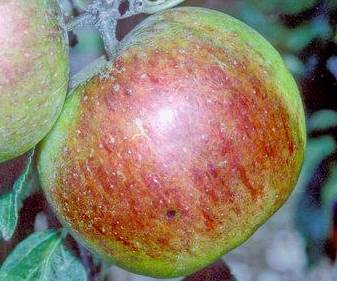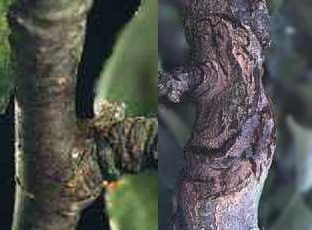HISTORY OF ELLISON’S ORANGE
One of the parents of Ellison’s Orange is Cox’s Orange Pippin and the other is not 100% confirmed but is almost certainly the French variety Calville Blanc according to Brogdale.
It was bred by Rev. Ellison in Lincolnshire and first marketed in 1911 by Pennells Nurseries near Lincoln who are still trading as a garden centre and plant nursery today. In the same year it received an Award of Merit from the RHS and still holds an Award of Garden Merit (1993).
APPEARANCE, TASTE AND CHARACTERISTICS OF ELLISON’S ORANGE
As far as looks go this variety gas it all. A green background, heavily striped red mainly on the sun side. The red colour turns more orange in couple of weeks just before the apples fully ripen.
The skins are about average for thickness and the key feature of the large amount of juice in the flesh. Medium sweet with a full flavour. Much is made of the potential aniseed flavour but in our opinion it is barely noticeable except when over-ripe.

The storage life is very short, a week at most after being picked. This can be spread over a week or two more by not harvesting all the apples at once.
Ellison’s Orange is partially fertile so it will produce a good crop of apples as a stand alone tree but it will be more productive if a matching pollination partner is nearby.
The growing strength of the tree is average and you can expect to begin harvesting apples two years after planting. It will reach maximum cropping potential after three more years. This is a mid season apple and harvest dates are somewhere between mid September to mid October depending on where you live (see below for specific dates in your area).
Blossom is produced late in the season which makes Ellison’s Orange a good choice for cooler areas of the UK. Combine this with good resistance to bitter pitter pit and scab makes another reason for its suitability for cooler areas. Canker is a serious problem however, so wet and moist parts of the country should be avoided.
BUYING AN ELLISON’S ORANGE APPLE TREE
Readily available from online suppliers, you may well find it also sold in some garde centres. It is not generally sold in the discounted outlets such as Aldi, Lidl, Sainsburys etc.
It is clear that the prices of quality trees varies enormously depending on your chosen supplier. For example Keepers Nursery look good at first glance. However an advertised price of only £16.50 turns into an exceptionally high £31.00 when you add in their £14.50 delivery charge!
VAT, delivery charges and other incidentals all need to be taken into account! We would also advise that buying a bare-rooted Ellison’s Kernel is roughly £10 cheaper than the equivalent potted tree. There is no difference in quality so always try to buy the bare-rooted tree.
Our recommendation for rootstock would be to buy it on either M26 or MM106 for the average sized garden.
PESTS AND DISEASES OF ELLISON’S ORANGE
This variety has good overall pest and disease resistance but canker is a major problem. To stand a chance of success, avoid Ellison’s Orange if you live in the wetter parts of the UK. It is ridiculously difficult to create a map of the UK showing average rainfall because a cursory glance of the maps produced show huge differences in opinion.
Some show the entire area of Scotland to be a blackspot as far as rainfall is concerned, others show the west of Scotland to be below average. This difference of opinion spreads all over the UK. Only you really know if your particular area is wetter than average, so trust your own local experience.
Canker damages the bark of the tree and the only solution is to cut it out as soon as as you notice it. Early action reduces the risk of further infections. See the picture below:

Canker damage to a fruit tree
For more information about identifying, treating and avoiding canker see our dedicated page for this disease here.
HOW TO PRUNE YOUR ELLISON’S ORANGE APPLE TREE
This variety is about average as far as tree vigour is concerned so you should have no particular problems pruning it if you follow our step by step guide here.
Ellison’s Orange is a partial tip bearer which means that some of the fruit buds at the end of stems, just where they are likely to be pruned off. This is not normally a problem because sufficient buds are normally produced further back down the stems. Check out our section on pruning partial tip-bearing apple trees for more detailed information.
Because this particular variety is prone to canker we would always inspect the tree more regularly compared to other varieties so that any problems can be dealt with before they get out of hand.
ALTERNATIVES TO ELLISON’S ORANGE
When looking for an alternative to Ellison’s Orange take into account the excellent flavour of this variety. You will be looking for a mid season variety which produces good looking and full coloured apples. Disease resistance will need to be good.
Cox’s Orange Pippin does not appear in the list below because it has significant pest and disease problems. A few varieties which fit the replacement criteria are:
- RED FALSTAF – a widely available sport of Falstaff. Taste is nearly as good and pest / disease resistance is far better.
- FIESTA – taste is excellent, the apples are very appealing and pest / disease resistance far exceeds that of the Cox.
- SUNSET – slightly more acidic but only slightly. Tip top disease resistance. This is our choice for a container grown tree or for smaller gardens, the apple size is slightly smaller than average.
- LAXTON’S SUPERB – one of the top three best tasting apples of all time in our view. Slightly sweeter than Ellison’s Orange but still lots of apple flavour. This variety has no drawbacks, a great tasting apple with superb looks and good pest / disease resistance. This would be our personal choice for an apple tree variety to replace Ellison’s Orange.
SUMMARY CHARACTERISTICS OF ELLISON’S ORANGE
USE: Eating
SKIN COLOUR / TEXTURE: Green background highly flushed red / orange on the sun side
FLESH COLOUR: White
TASTE AND TEXTURE: Excellent, balanced taste. Enough juice to float a boat!
FRUIT SIZE: Average
STORING QUALITIES: One to two weeks
SUITABILITY FOR CORDON / ESPALIER GROWTH: Yes
TREE SIZE: Average size depending on rootstock and conditions
REGULARITY OF CROPPING: Regular
POLLINATION: Group 4, partially self-fertile. Will produce a larger crop with a matching pollination partner.
AWARDS: RHS AGM 1993
SPECIAL FEATURES: Good for cooler areas if not damp. Excellent taste, lots of juice.
WHEN TO HARVEST ELLISON’S ORANGE APPLES
The average flowering time (optimum time for pollination) and date when fruits are ripe in the UK for the Ellison’s Orange variety are set out below. If you have set your home town we can give you a more accurate estimate, if you have not set your home town (do it now by clicking here) the dates below will be the average for the UK.
Your town has not been set, the average main flowering time for Ellisons Orange
in the UK is the second week of May. Fruit will be ready for harvesting in the last week of September.
Click here if you want to set the dates to your home town.
Flowering and fruit picking dates vary according to the weather in any particular growing season so the above dates may well change slightly from one year to the next. The flowering date above is when the apple tree produces the maximum number of blossoms, it will also produce blossom, although less, a week or two either side of the date given.
ELLISON’S ORANGE POLLINATION
Ellison’s Orange is in pollination Group 4 and will produce a reasonable crop of apples as a stand alone tree in most years. In less favourable years it does produce a larger crop if a suitable pollination partner is nearby. We list below varieties which are suitable pollination partners.
- Arthur Turner – pollination group 3, self-sterile, cooker
- Braeburn – pollination group 4, self-fertile, eater
- Charles Ross – pollination group 3, partially self-fertile, cooker and eater
- Court of Wick – pollination group 3, self-sterile, eater and cooker
- Discovery – pollination group 3, self-sterile, eating and cider
- Dumelows Seedling – pollination group 4, self-sterile, cooker
- Gala – pollination group 4, partially self-fertile, eater
- Golden Delicious – pollination group 4, partially self-fertile, eater and cooker
- Granny Smith – pollination group 3, self-fertile, eater and cooker
- Grenadier – pollination group 3, partially self-fertile, cooker
- Honeycrisp – pollination group 4, self-sterile, eater
- Howgate Wonder – pollination group 3, partially self-fertile, cooker and eater
- Katy – pollination group 3, self-sterile, both
- King of The Pippins – pollination group 4, partially self-fertile, eater and cooker
- Lanes Prince Albert – pollination group 4, self-sterile, cooking
- Lord Derby – pollination group 4, self-sterile, cooker
- Lord Lambourne – pollination group 2, self-fertile, eater and cooker
- Newton Wonder – pollination group 4, partially self-fertile, cooker
- Peasgoods Nonsuch – pollination group 3, partially self-fertile, cooker
- Rajka – pollination group 4, self-sterile, eater
- Red Falstaff – pollination group 3, self-fertile, eater
- Scrumptious – pollination group 3, self-fertile, eater
- Sops in Wine – pollination group 3, self-sterile, juicer
- Spartan – pollination group 3, self-fertile, eater
- Waltz – pollination group 3, self-sterile, eater
- Worcester Pearmain – pollination group 3, partially self-fertile, eater
The full list of apple tree varieties which we have reviewed is listed below. Select any one of them and then click the “More Information” button to be taken to the in depth review:
Rootstocks and Size
Guide to Planting
Care Plan
Pruning Apple Trees
Harvest and Storage
Pests and Disease
Pollination Groups
ELLISON’S ORANGE APPLE TREE
Ellison’s Orange dates back to the early 1900s and is still a favourite of many apple connoisseurs. Taste is excellent and full bodied but don’t expect quite the same crunchy texture of a Cox. Your Ellison’s is a far juicier apple.
Disease resistance to scab and and bitter pit is good although canker is a definite weak area. If your ground is well-drained this variety will grow well in the South and North of the UK.